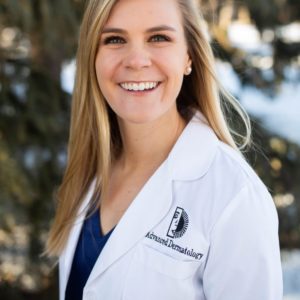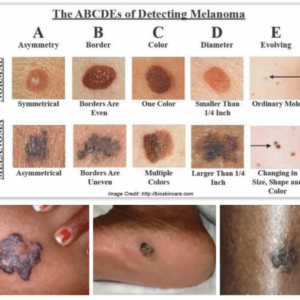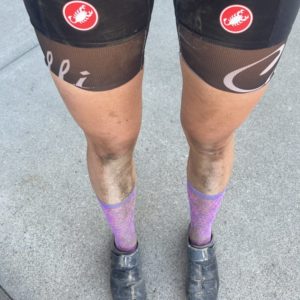Shedding Light On Skin Cancer Risks For Cyclists
Written by Rachel Brown PA-C
Originally published on FortFollies.com and republished with permission.

There are few better feelings than finishing a hard ride, sweat on your face, sun on your skin with a nice tailwind as you speed through scenic landscapes. Although cycling does have numerous health benefits, sun exposure from cycling is not without risk. According to the Skin Cancer Foundation, skin cancer is the most common type of cancer, affecting 1 in 5 Americans by the time they reach age 70. Aside from increased risk of skin cancer, most of the changes in our skin (thinning, easy bruising, wrinkles) we attribute to aging are actually due to sun exposure over our lifetime.
My skin cancer awareness journey began three years ago when I started working as a physician assistant in the field of dermatology. Diagnosing skin cancer on a daily basis and seeing the severe damage from UV radiation opened my eyes very quickly. I’ve worked with patients who have lost loved ones prematurely due to metastatic melanoma, who have had significant cosmetic alterations due to skin cancers (and treatment of such) on their face, and who deal with chronic wounds from skin tears as a result of thinned skin. I love to spend time outside recreating and am passionate about finding a balance between doing the things you love and protecting your skin. With summer in full swing, this is a friendly reminder that skin cancer is very common, and, aside from genetics, is also very preventable. In this article, I would like to debunk a few common myths regarding skin cancer and prevention of such and discuss practical measures to preventing skin cancer while recreating outside.
Mythbusters:
Myth 1: Sunscreen causes vitamin D deficiency
Numerous studies have shown that there is a significant variability in vitamin D status, despite more than adequate sun exposure. One study looked at young healthy adults living in Honolulu, Hawaii with a mean self-reported sun exposure without sunscreen of 22.4 hours per week (1). This study showed that 51% of this population had a low vitamin D status concluding that high amounts of sun exposure does not ensure that an individual has adequate vitamin D levels. If you’re worried about vitamin D deficiency, I would discuss what starting a vitamin D supplement looks like for you with your regular doctor.
Myth 2: Sunscreen causes cancer
Two summers ago, Valisure, a pharmaceutical analytical service company published a study indicating more than 50 sunscreen products contain benzene, a contaminant known to cause cancer (2). Of note, most of the sunscreens they listed were spray sunscreens which generally aren’t recommended by dermatologists due to poor coverage. Other reports have come out showing chemical ingredients in sunscreen are absorbed into the bloodstream, but we do not yet know the significance of this absorption. It is my professional and personal opinion that the benefits of sunscreen (preventing skin cancer and premature death from melanoma) far outweigh the hypothetical risk of absorption of chemicals in sunscreen. Broad spectrum (both chemical and physical/mineral) sunscreens are recommended because both are necessary to cover the entire UV spectrum. If you have concerns regarding chemical absorption, you can consider a sheer mineral sunscreen or wear sun protective clothing as an alternative to broad spectrum sunscreen.
Myth 3: Covering up is enough
Patients commonly ask “I always have pants on (or a shirt on) – why did I get melanoma on my thigh (or back)”? The short answer – clothing is not as protective as we think it is. A typical white cotton T-shirt offers a UPF of 5. UPF stands for ultraviolet protection factor and measures the extent to which fabric can block ultraviolet radiation from the sun. UPF is determined by a number of factors including the way in which the fabric is woven together, type of fabric, color (darker is better), thickness, tension, fabric wetness, and fabric condition/wear. Thankfully, we live in a day and age where UPF clothing is becoming more available. Several brands make jerseys, bibs, socks, skull caps, and sleeves with UPF of 30 or above. We generally recommend UPF of 30 or above.
Let’s Get Practical:
1. Know what to look for
When we talk about skin cancer, there are two main categories – non-melanoma (basal cell carcinoma and squamous cell carcinoma) and melanoma. Non-melanoma skin cancers are commonly red and scaly. Patients often describe them as “a spot that feels like sandpaper” or “doesn’t moisturize”, something that bleeds spontaneously, a “non-healing pimple” after 4-6 weeks, a spot that scabs, heals, scabs in the exact same place, a spot that is red, raised, and painful to touch. Melanoma or dysplastic (abnormal) moles are commonly brown.
melanoma. Non-melanoma skin cancers are commonly red and scaly. Patients often describe them as “a spot that feels like sandpaper” or “doesn’t moisturize”, something that bleeds spontaneously, a “non-healing pimple” after 4-6 weeks, a spot that scabs, heals, scabs in the exact same place, a spot that is red, raised, and painful to touch. Melanoma or dysplastic (abnormal) moles are commonly brown.
You can use the ABCDE mnemonic to remember what to look for. Asymmetrical in appearance. Border is scalloped or jagged. Color – 3 or more colors is concerning, gray can be a concerning color in the skin. Diameter greater than a pencil eraser. Evolution – a spot that has been stable that takes off growing or changing. Funny looking/ugly duckling – if you have one brown spot that looks like another brown spot on your body, that is more reassuring than “I have this spot and it looks like nothing else on my body”.
2. Don’t forget the commonly forgotten
Scalp: A study analyzing UV exposure amongst cyclists showed that the top of the scalp received double the UV radiation as the ankle (3). Cyclists tend to forget that most helmets have vents. Those with thinning or shorter hair – remember to apply sunscreen to your scalp or wear a UPF cap underneath your helmet.
Lips: According to the Skin Cancer Foundation, 81% of lip cancers occur on the lower lip. Let me tell you – lips are a complicated place to get skin cancer. Using a lip balm with sun protection before and during rides can protect your lips. Two of my favorite products are Aquaphor Lip Repair Stick + Sunscreen and Elta MD UV Lip Balm.
Eyes: You can also get cancer in your eyes from sun exposure over your lifetime. A patient once described her squamous cell carcinoma in her eye to me as “feeling like a piece of sand that wouldn’t go away for months” – how awful does that sound?! When purchasing sunglasses, always choose sunglasses that provide 100% UVA/UVB protection. Don’t be fooled – darker lenses don’t automatically guarantee more protection.
Provider pearl: The most common area I professionally see skin cancer in cyclists is on their lower legs. 
3. Wear sunscreen (or UPF clothing or dirt !)
Thankfully, protecting against harmful UV rays doesn’t have to be burdensome. We generally recommend sweat and water resistant sunscreen of SPF 30 or above to be applied 20 minutes before a ride. It is recommended to reapply every 2 hours of sun exposure or every 80 minutes if you’re sweating heavily. Don’t forget to lay it (sunscreen) on thick! A study performed by the University of Copenhagen Department of Dermatology showed that people who applied sunscreen once missed a median of 20% of their available body surface area but only missed 9% after another application (4). This study (and several others) showed the proportion of people who had high quality application of sunscreen greatly increased after applying it twice.
If you don’t want to apply twice or apply a thick coat of sunscreen, opt for a higher SPF. Start to intentionally purchase cycling jerseys and bib shorts with UPF of 30 or above. Sun sleeves, caps, and gloves are a good way to protect your skin without having to worry about reapplying sunscreen.
My favorite sunscreen for facial use during sports related activities is Elta MD UV Sheer, for body during sports activities Elta MD UV Sport. Not sponsored, I just really love this brand! For cyclists, stick sunscreens are a good option as they are compact in size and your hands don’t get greasy from reapplication.
4. Get your skin checked!
It never hurts to get a baseline exam with a dermatologist or dermatology physician assistant. According to the Skin Cancer Foundation, five or more sunburns more than doubles your risk of developing melanoma. People commonly ask how often they should get their skin examined by a dermatologist. There is no clear guidance in people under the age of 65, with no personal history of skin cancer, and no family history of melanoma, on how often to do full body skin cancer screenings. Most dermatologists agree every 2-3 years is adequate frequency. If you have numerous moles or a history of tanning bed use, more frequent exams may be recommended. You and your dermatologist together can determine the frequency that is best for you.
As cycling enthusiasts, we often prioritize our physical fitness and performance while overlooking the potential risks of sun exposure. Understanding the importance of protecting our skin against harmful UV damage is vital in preventing skin cancer. By adopting simple yet effective measures like applying sunscreen twice, wearing proper UPF clothing and accessories, and not forgetting to protect high risk areas, we can continue enjoying our beloved sport while safeguarding our skin’s health. So gear up, lather it on, and ride towards safer and more beautiful skin!
(1) N. Binkley and others, Low Vitamin D Status despite Abundant Sun Exposure, The Journal of Clinical Endocrinology & Metabolism, Volume 92, Issue 6, 1 June 2007, Pages 2130–2135, https://doi.org/10.1210/jc.2006-2250
(2) Light, David, et al. “Valisure Citizen Petition on Benzene in Sunscreen and After-Sun Care Products.” Received by Division of Dockets Management Food and Drug Administration, 24 May 2021, New Haven, Connecticut.
(3) Kimlin, Michael G., et al. “Anatomical Distribution of Solar Ultraviolet Exposures among Cyclists.” Journal of Photochemistry and Photobiology B: Biology, vol. 85, no. 1, 2 Oct. 2006, pp. 23–27, https://doi.org/10.1016/j.jphotobiol.2006.04.004.
(4) Heerfordt, Ida M., et al. “Sunscreen Use Optimized by Two Consecutive Applications.” PLOS ONE, vol. 13, no. 3, 28 Mar. 2018, https://doi.org/10.1371/journal.pone.0193916.
Rachel Brown PA-C
Advanced Dermatology
Rachel is passionate about providing high-quality, patient centered, compassionate care and is looking forward to building lasting relationships with her patients. She has a special focus on skin cancer screening, prevention and treatment as well as common skin conditions including acne, psoriasis, eczema, rashes, and hair and nail disorders. She also offers cosmetic dermatology consultations and performs a number of cosmetic procedures.
Rachel graduated Magna Cum Laude with a degree in biochemistry from the University of Kansas in Lawrence and completed her master’s in Physician Assistant Studies at the University of Nebraska Medical Center in Omaha. After graduation, she worked as a physician assistant in hospital medicine and in the emergency room prior to having the opportunity to work in the field of dermatology. As a Colorado native, she is excited to be back in Colorado, caring for the people who live in a region so close to her heart.
She is a member of the American Academy of Physician Assistants (AAPA) and the Society of Dermatology Physician Assistants (SDPA) and is certified by NCCPA.
Outside of the office, Rachel enjoys triathlons, running with her vizsla Ralph and hiking in Colorado (including Colorado’s fourteeners) and all over the world. She has summited Mt. Kilimanjaro and hiked to Everest Base Camp. She and her fiancé enjoy volunteering at their local church and in the community.
If you enjoy this content and appreciate the hustle that goes into YGR please consider supporting the site.






